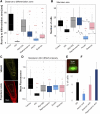Diverse Allyl Glucosinolate Catabolites Independently Influence Root Growth and Development
- PMID: 32321840
- PMCID: PMC7333702
- DOI: 10.1104/pp.20.00170
Diverse Allyl Glucosinolate Catabolites Independently Influence Root Growth and Development
Abstract
Glucosinolates (GSLs) are sulfur-containing defense metabolites produced in the Brassicales, including the model plant Arabidopsis (Arabidopsis thaliana). Previous work suggests that specific GSLs may function as signals to provide direct feedback regulation within the plant to calibrate defense and growth. These GSLs include allyl-GSL, a defense metabolite that is one of the most widespread GSLs in Brassicaceae and has also been associated with growth inhibition. Here we show that at least three separate potential catabolic products of allyl-GSL or closely related compounds affect growth and development by altering different mechanisms influencing plant development. Two of the catabolites, raphanusamic acid and 3-butenoic acid, differentially affect processes downstream of the auxin signaling cascade. Another catabolite, acrylic acid, affects meristem development by influencing the progression of the cell cycle. These independent signaling events propagated by the different catabolites enable the plant to execute a specific response that is optimal to any given environment.
© 2020 American Society of Plant Biologists. All Rights Reserved.
Figures







Similar articles
-
Defense versus growth trade-offs: Insights from glucosinolates and their catabolites.Plant Cell Environ. 2023 Oct;46(10):2964-2984. doi: 10.1111/pce.14462. Epub 2022 Oct 21. Plant Cell Environ. 2023. PMID: 36207995
-
The Defense Metabolite, Allyl Glucosinolate, Modulates Arabidopsis thaliana Biomass Dependent upon the Endogenous Glucosinolate Pathway.Front Plant Sci. 2016 Jun 1;7:774. doi: 10.3389/fpls.2016.00774. eCollection 2016. Front Plant Sci. 2016. PMID: 27313596 Free PMC article.
-
The glucosinolate breakdown product indole-3-carbinol acts as an auxin antagonist in roots of Arabidopsis thaliana.Plant J. 2015 May;82(4):547-55. doi: 10.1111/tpj.12824. Epub 2015 Apr 13. Plant J. 2015. PMID: 25758811
-
Comparison of glucosinolate diversity in the crucifer tribe Cardamineae and the remaining order Brassicales highlights repetitive evolutionary loss and gain of biosynthetic steps.Phytochemistry. 2021 May;185:112668. doi: 10.1016/j.phytochem.2021.112668. Epub 2021 Mar 17. Phytochemistry. 2021. PMID: 33743499 Review.
-
A Comprehensive Gene Inventory for Glucosinolate Biosynthetic Pathway in Arabidopsis thaliana.J Agric Food Chem. 2020 Jul 15;68(28):7281-7297. doi: 10.1021/acs.jafc.0c01916. Epub 2020 Jul 1. J Agric Food Chem. 2020. PMID: 32551569 Review.
Cited by
-
Plant Responses Underlying Timely Specialized Metabolites Induction of Brassica Crops.Front Plant Sci. 2022 Feb 3;12:807710. doi: 10.3389/fpls.2021.807710. eCollection 2021. Front Plant Sci. 2022. PMID: 35185956 Free PMC article.
-
Assessing Radish Health during Space Cultivation by Gene Transcription.Plants (Basel). 2023 Sep 30;12(19):3458. doi: 10.3390/plants12193458. Plants (Basel). 2023. PMID: 37836197 Free PMC article.
-
Phytohormones in a universe of regulatory metabolites: lessons from jasmonate.Plant Physiol. 2024 Apr 30;195(1):135-154. doi: 10.1093/plphys/kiae045. Plant Physiol. 2024. PMID: 38290050 Free PMC article. Review.
-
Microbe-dependent heterosis in maize.Proc Natl Acad Sci U S A. 2021 Jul 27;118(30):e2021965118. doi: 10.1073/pnas.2021965118. Proc Natl Acad Sci U S A. 2021. PMID: 34285069 Free PMC article.
-
Quantitative Time-Course Analysis of Osmotic and Salt Stress in Arabidopsis thaliana Using Short Gradient Multi-CV FAIMSpro BoxCar DIA.Mol Cell Proteomics. 2023 Nov;22(11):100638. doi: 10.1016/j.mcpro.2023.100638. Epub 2023 Sep 12. Mol Cell Proteomics. 2023. PMID: 37704098 Free PMC article.
References
-
- Agrawal AA, Strauss SY, Stout MJ(1999) Costs of induced responses and tolerance to herbivory in male and female fitness components of wild radish. Evolution 53: 1093–1104 - PubMed
-
- Bartling D, Seedorf M, Mithöfer A, Weiler EW(1992) Cloning and expression of an Arabidopsis nitrilase which can convert indole-3-acetonitrile to the plant hormone, indole-3-acetic acid. Eur J Biochem 205: 417–424 - PubMed
-
- Barton KE, Koricheva J(2010) The ontogeny of plant defense and herbivory: Characterizing general patterns using meta-analysis. Am Nat 175: 481–493 - PubMed
-
- Bednarek P, Pislewska-Bednarek M, Svatos A, Schneider B, Doubsky J, Mansurova M, Humphry M, Consonni C, Panstruga R, Sanchez-Vallet A, et al. (2009) A glucosinolate metabolism pathway in living plant cells mediates broad-spectrum antifungal defense. Science 323: 101–106 - PubMed
Publication types
MeSH terms
Substances
Grants and funding
LinkOut - more resources
Full Text Sources

